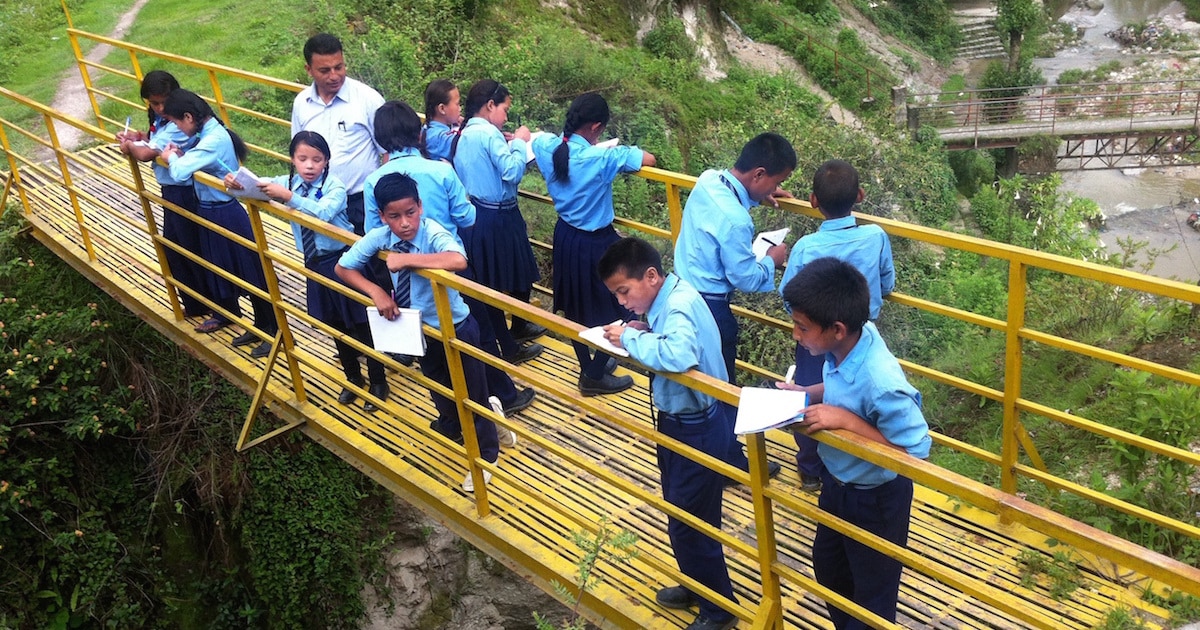In pretty much everything I do with science teachers in Nepal, whether at Jana Uddhar School or elsewhere, my aims are three-fold:
- change the way the teachers approach teaching
- make science fun for both the teachers and students
- using resources readily available to them.
If I am even just a bit successful with any one of them, I am confident that there will be considerable change in the learning outcomes of the students. Most importantly, all that will teach students to think.
Not long after I conducted the lesson on Life Processes, I did another activity for the fifth graders: I took them on a “field trip.” At a government school in Nepal, that, of course, is a novel activity!
Discussing a lesson, I had suggested a visit to the neighboring river to Buddhi, their Science Teacher. They had just finished the topic Life Process/Living Things. They were wrapping up The Effects of Human Activity on Nature (i.e. Environmental Pollution). The next topic was Environmental Conservation. Given that, the river-visit was a perfect way to reinforce, in a real and tangible way, what they had already learned in the classroom and to prepare them for what they would be learning next.
So last Monday, after a brief introduction, Buddhi and I took the students to the river. They were to make notes on all signs of human and animal activities in and around the river and to think about how that might be affecting the river and the environment.
The following are some images from that trip. (Click on an image to browse.)
The students start off on a bridge (photo 1), next to an outhouse (photo 2), observing a small gorge on which they are building a dam (photo 3). Photo 4 is also of the students on the bridge showing the river in the background to the right.
Photo 5 shows signs of animal activity on the bank and in the background is the platform where dead bodies are cremated. The next photo (5) shows the river as seen from the cremation platform.
Photo 6 is looking upstream, while 6 shows the slippers worn by the farmers working on the field (in the backgrounds). (They had come over to take shelter when it had started to rain.) The last photo shows some coals in the foreground, from the cremation platform most likely, and the two young farmers in the background.
Following the trip, we had a brief session in the classroom. The children shared what they saw and how the river and life in it were affected by them etc. Not surprisingly, many of them already knew most of what they needed to learn. What’s more, because of that, we were able to go even beyond what was in the textbook — like to discussing the impact of these human activities on living things in the river, such as fish, down stream, way down stream like in the Terai (the Southern Plains), and the effect of leached fertilizers from the fields etc.
Buddhi was supposed to conduct the follow-up activity. The students were to draw diagrams of the areas they visited and identify the things/signs of activities in and around the river, and how they affect the river.
More than anything, in addition to the trip being fun — because it was probably something they had never done in the past — the trip would have made them think about their environment in ways they had probably never been asked or challenged to…or so I believe!
The more students engage in activities such as these, the more they’ll be forced to think about, and take into consideration, that which they probably never have!
What’s the point of formal education if it doesn’t do some of that from time to time?!
Aug. 25, 2016 Update
I visited the visited the school last Tuesday after a long time. (Breaks, exams, and my obligations etc. came in the way.) Buddhi sir indeed had carried out the follow-up activity — mapping out the river surroundings. The drawings were displayed in the classroom. Here they are. (Click on an image to browse.)

